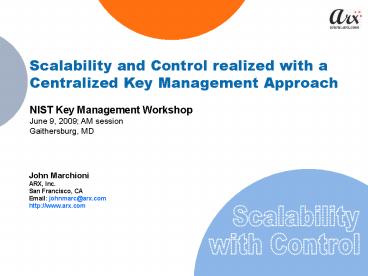CoSign Digital Signatures PowerPoint PPT Presentation
1 / 15
Title: CoSign Digital Signatures
1
Scalability and Control realized with
aCentralized Key Management Approach NIST Key
Management WorkshopJune 9, 2009 AM
session Gaithersburg, MD
John Marchioni ARX, Inc. San Francisco, CA Email
johnmarc_at_arx.com http//www.arx.com
Scalability
with Control
2
ARX, Inc.
- Core focus cost-efficient, scalable, and secure
PKI applications for industry. - First to market with a network-attached,
multi-user HSM (PrivateServer) - First to market with a centralized key-management
solution for end-user digital signatures
(CoSign) - ARX implements solutions for both public and
private sectors - ARX solutions are gaining in adoption precisely
because of their scalability, security, ease of
deployment and ease of use.
3
Agenda
- Obstacles with Key Distribution
- Distributing Managing Key Media
- Revocation breaks down when key is out of reach
- Auditing Key Actions and Key Usage
- Overall, control and scalability are crude
- Alternative Centralized Key Management
- Lower Administrative Burden
- Lower Processing Overhead
- Flattened Learning Curve for End Users
- Result is refined control with scalability
- QA
4
Observations
Traditional PKI systems are based on
distributing keys to the end users, which, aside
from security concerns Marchesini, creates a
high burden in logistics, cost, help desk support
and user acceptance Whitten and also introduces
training obstacles Nielsen.
Ref S. Turner and R. Housley, Implementing
Email Security and Tokens Current Standards,
Tools, and Practices pp.159, Wiley Publishing,
2008.
5
Key Management Background
- Key management supports these 3 basic
applications - Digital Signatures
- Access Control
- Confidentiality
- Key distribution may work well enough for things
like session confidentiality, and devices that
require access control, but the model does not
scale well and tends to break down when end-users
also require key services.
6
The Control Issue, e.g., A Runaway Stage
7
Similar Issue with Key Distribution
Systems Admin, or Security Officer
I cant remember where I left mine.
I have work to do but left my key at home.
8
Key Distribution Issues
Nature of Key Distribution
Issue
9
Key Distribution Issues (contd)
Nature of Key Distribution
Issue
- Certificate revocation alone does not turn the
user off a distinct disadvantage for
maintaining proper controls - Extra operational overhead, must physically
retrieve the key (i.e., the HW token or PC)
for key revocation. - Delayed production, with administrative
overhead - End-user learning curve (for the non-PKI
literate, and most users are not PKI
literate) - - user is not familiar with key generation
process - - user-to-RA/CA interaction is confusing.
10
Key Distribution Issues (contd)
11
Centralized Key Management
Nature of
Advantages
Centralized Key Management
Key Media HW token secure, centralized
appliance, I.e., FIPS 140-2 level 3
evaluated, network- attached, multi-user HSM
12
Centralized Key Management (contd)
Nature of
Advantages
Centralized Key Management
13
Summary
- Centralized key management offers obvious control
and audit advantages over key distribution. - Centralized key management alleviates many
administrative and cost burdens. - Scalability requires the end-user low touch,
proper controls, and minimization of cost and
administrative overhead as offered by the
centralized approach. - Organizations of all sizes (very largest to the
small) can benefit from the control and
scalability, offered by centralized key
management strategies, and will find such
strategies are both more affordable and durable.
14
References
- C. Ellison, Improvements on Conventional PKI
Wisdom, Proceedings of the 1st Annual PKI
Research Workshop, pp. 165-176, August 2002. - FIPS140 National Institute of Standards and
Technology (NIST), FIPS Publication 140-2
Security Requirements for Cryptographic Modules,
May 2001. - S. Gupta, Security Characteristics of
Cryptographic Mobility Solutions, Proceedings of
the 1st Annual PKI Research Workshop, pp.
117-126, August 2002. - M. Lorch, J. Basney and D. Kafura, A
Hardware-secured Credential Repository for Grid
PKIs, 4th IEEE/ACM International Symposium on
Cluster Computing and the Grid, pp. 640-647,
April 2004. - J. Marchesini, S.W. Smith, M. Zhao, Keyjacking
Risks of the Current Client-side Infrastructure,
Proceedings of the 2nd Annual PKI Research
Workshop, pp. 128-144, April 2003. - NAMU and Directory-Driven HSM Appliance S.
Turner and R. Housley, Implementing Email
Security and Tokens Current Standards, Tools,
and Practices pp.159-160, Wiley Publishing,
2008. - R. Nielsen, Observations from the Deployment of
a Large Scale PKI, Proceedings of the 4th Annual
PKI Research Workshop, pp. 159-165, August 2005. - A. Whitten and J.D. Tygar, Why Johnny Cant
Encrypt A Usability Evaluation of PGP 5.0,
Proceedings of the 8th USENIX Security Symposium,
pp. 169-184, August 1999.
15
For those viewing via webcast, please submit
questions for this presentation to
kmwquestions_at_nist.gov
What do you think?
Scalability
http//www.arx.com
with Control

